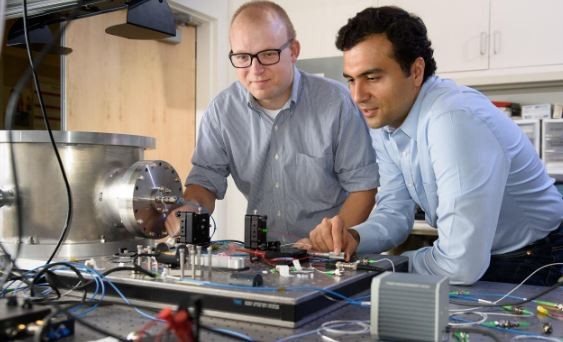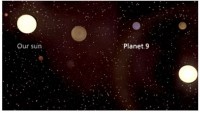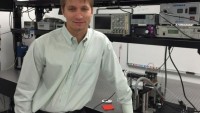Stanford Researchers Develop Powerful Light-based Computer for Solving Very Complex Problems
| Arthur Dominic Villasanta | | Oct 21, 2016 02:35 AM EDT |
(Photo : L.A. Cicero) Post-doctoral scholar Peter McMahon and visiting researcher Alireza Marandi examine a prototype of a new type of light-based computer.
An entirely new type of computer blending optical and electrical processing and capable of finding more optimal solutions to problems with an incredibly high number of possible solutions has been built by a team from Stanford University.
This computer is called an "Ising Machine." It's named after the "Ising Model," a mathematical model of ferromagnetism in statistical mechanics. In turn, the Ising Model is named after the German physicist Ernst Ising who died in the U.S. in 1998.
Like Us on Facebook
The Ising Model is defined on a discrete collection of variables called "spins," which can take on the value 1 or -1.
Standford's Ising Machine reported Oct. 20 in the journal Science acts like a reprogrammable network of artificial magnets where each magnet only points up or down and, like a real magnetic system, is expected to tend toward operating at low energy.
The theory is that if the connections among a network of magnets can be programmed to represent the problem at hand, the solution can be derived from their final state once they settle on the optimal, low-energy directions they should face.
Rather than using magnets on a grid, however, the Stanford team used a special kind of laser system known as a "degenerate optical parametric oscillator" that represents an upward- or downward-pointing "spin" when switched on.
In an earlier version of this machine (published two years ago), team members extracted a small portion of each pulse, delayed it and added a controlled amount of that portion to the subsequent pulses.
Pulse-to-pulse couplings constitute the programming of the problem. The machine is turned on to try to find a solution, which can be obtained by measuring the final output phases of the pulses.
The latest Stanford Ising machine shows that a drastically more affordable and practical version could be made by replacing the controllable optical delays with a digital electronic circuit.
The circuit emulates the optical connections among the pulses in order to program the problem and the laser system still solves it.
Nearly all of the materials used to make this machine are off-the-shelf elements already used for telecommunications. This advantage in combination with the simplicity of the programming makes it easy to scale-up the size of the machine.
Stanford's machine is currently able to solve 100-variable problems with any arbitrary set of connections between variables. It's been tested on thousands of scenarios.
A group at NTT in Japan that consulted with Stanford's team has also created an independent version of the machine. Its study has been published alongside Stanford's by Science.
For now, the Ising machine still falls short of beating the processing power of traditional digital computers when it comes to combinatorial optimization. But it is gaining ground fast and researchers are looking forward to seeing what other work will be possible based on this breakthrough.
"I think it's an exciting avenue of exploration for finding alternative computers. It can get us closer to more efficient ways of tackling some of the most daunting computational problems we have," said Alireza Marandi, a former postdoctoral scholar at Stanford and co-author of the study..
"So far, we've made a laser-based computer that can target some of these problems, and we have already shown some promising results."
The processing power of standard computers is likely to reach its maximum in the next 10 to 25 years. Even at this maximum power, traditional computers won't be able to handle a particular class of problem that involves combining variables to come up with many possible answers, and looking for the best solution.
"This is a machine that's in a sense the first in its class, and the idea is that it opens up a sub-field of research in the area of non-traditional computing machines," said Peter McMahon, postdoctoral scholar in applied physics and co-author of the paper.
"There are many, many questions that this development raises and we expect that over the next few years, several groups are going to be investigating this class of machine and looking into how this approach will pan out."
TagsStanford University, Ising Machine, Ising Model i, Alireza Marandi, Peter McMahon
©2015 Chinatopix All rights reserved. Do not reproduce without permission
EDITOR'S PICKS
-

Did the Trump administration just announce plans for a trade war with ‘hostile’ China and Russia?
-

US Senate passes Taiwan travel bill slammed by China
-

As Yan Sihong’s family grieves, here are other Chinese students who went missing abroad. Some have never been found
-

Beijing blasts Western critics who ‘smear China’ with the term sharp power
-

China Envoy Seeks to Defuse Tensions With U.S. as a Trade War Brews
-

Singapore's Deputy PM Provides Bitcoin Vote of Confidence Amid China's Blanket Bans
-

China warns investors over risks in overseas virtual currency trading
-

Chinese government most trustworthy: survey
-

Kashima Antlers On Course For Back-To-Back Titles
MOST POPULAR
LATEST NEWS
Zhou Yongkang: China's Former Security Chief Sentenced to Life in Prison

China's former Chief of the Ministry of Public Security, Zhou Yongkang, has been given a life sentence after he was found guilty of abusing his office, bribery and deliberately ... Full Article
TRENDING STORY

China Pork Prices Expected to Stabilize As The Supplies Recover

Elephone P9000 Smartphone is now on Sale on Amazon India

There's a Big Chance Cliffhangers Won't Still Be Resolved When Grey's Anatomy Season 13 Returns

Supreme Court Ruled on Samsung vs Apple Dispute for Patent Infringement

Microsoft Surface Pro 5 Rumors and Release Date: What is the Latest?














